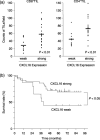Chemokine receptors in cancer metastasis and cancer cell-derived chemokines in host immune response
- PMID: 17894551
- PMCID: PMC11159633
- DOI: 10.1111/j.1349-7006.2007.00606.x
Chemokine receptors in cancer metastasis and cancer cell-derived chemokines in host immune response
Abstract
The chemotactic cytokines called chemokines are a superfamily of small secreted cytokines that were initially characterized through their ability to prompt the migration of leukocytes. Attention has been focused on the chemokine receptors expressed on cancer cells because cancer cell migration and metastasis show similarities to leukocyte trafficking. CXC chemokine receptor 4 (CXCR4) was first investigated as a chemokine receptor that is associated with lung metastasis of breast cancers. Recently, CXCR4 was reported to be a key molecule in the formation of peritoneal carcinomatosis in gastric cancer. In the present review, we highlight current knowledge about the role of CXCR4 in cancer metastases. In contrast to chemokine receptors expressed on cancer cells, little is known about the roles of cancer cell-derived chemokines. Cancer tissue consists of both cancer cells and various stromal cells, and leukocytes that infiltrate into cancer are of particular importance in cancer progression. Although colorectal cancer invasion is regulated by the chemokine CCL9-induced infiltration of immature myeloid cells into cancer, high-level expression of cancer cell-derived chemokine CXCL16 increases infiltrating CD8(+) and CD4(+) T cells into cancer tissues, and correlates with a good prognosis. We discuss the conflicting biological effects of cancer cell-derived chemokines on cancer progression, using CCL9 and CXCL16 as examples.
Figures





References
-
- Yoshie O, Imai T, Nomiyama H. Novel lymphocyte‐specific CC chemokines and their receptors. J Leukoc Biol 1997; 62: 634–44. - PubMed
-
- Yoshie O. Immune chemokines and their receptors: the key elements in the genesis, homeostasis and function of the immune system. Springer Semin Immunopathol 2000; 22: 371–91. - PubMed
-
- Zlotnik A. Chemokines and cancer. Int J Cancer 2006; 119: 2026–9. - PubMed
-
- Muller A, Homey B, Soto H et al . Involvement of chemokine receptors in breast cancer metastasis. Nature 2001; 410: 50–6. - PubMed
Publication types
MeSH terms
Substances
LinkOut - more resources
Full Text Sources
Other Literature Sources
Research Materials

